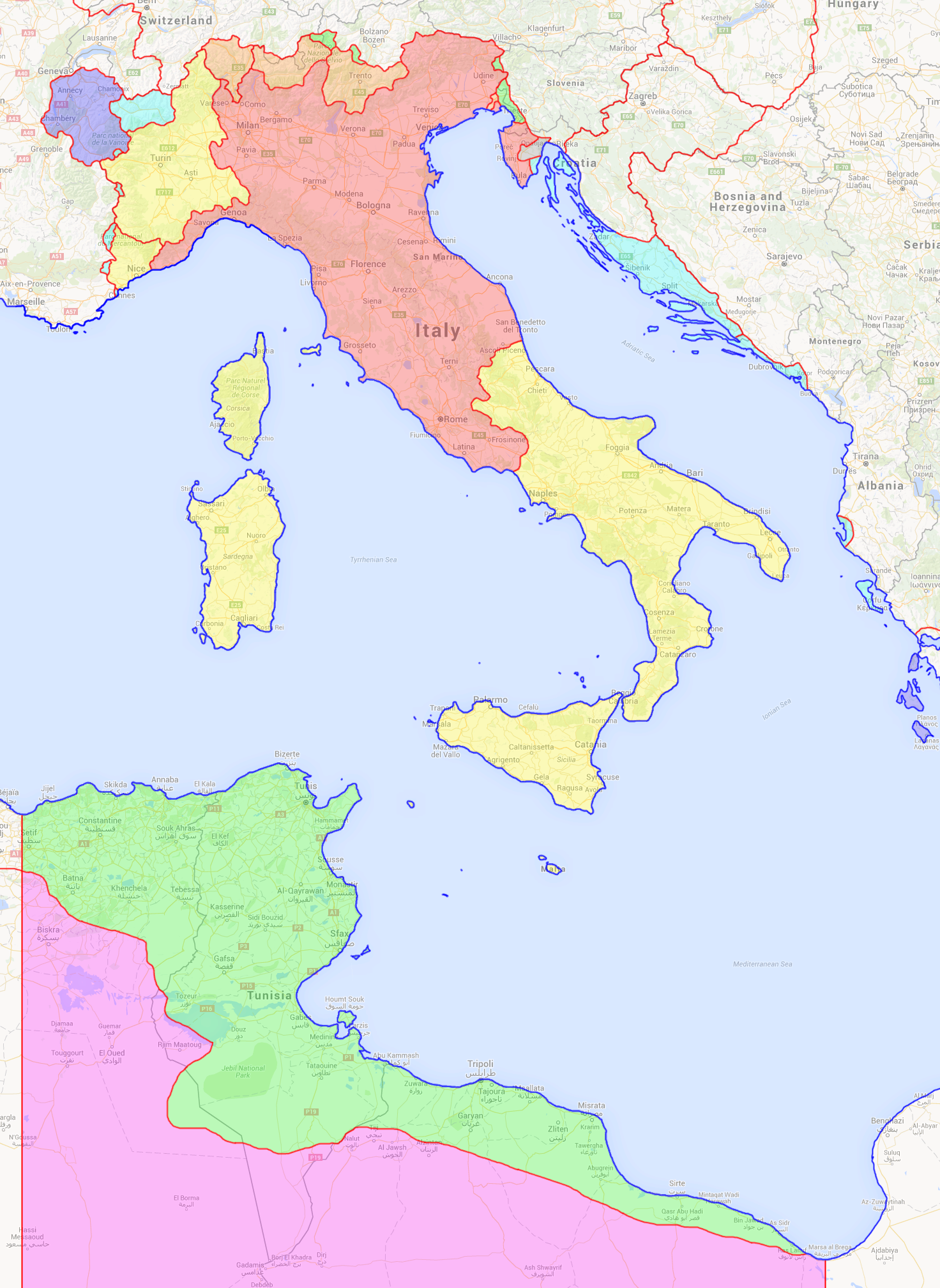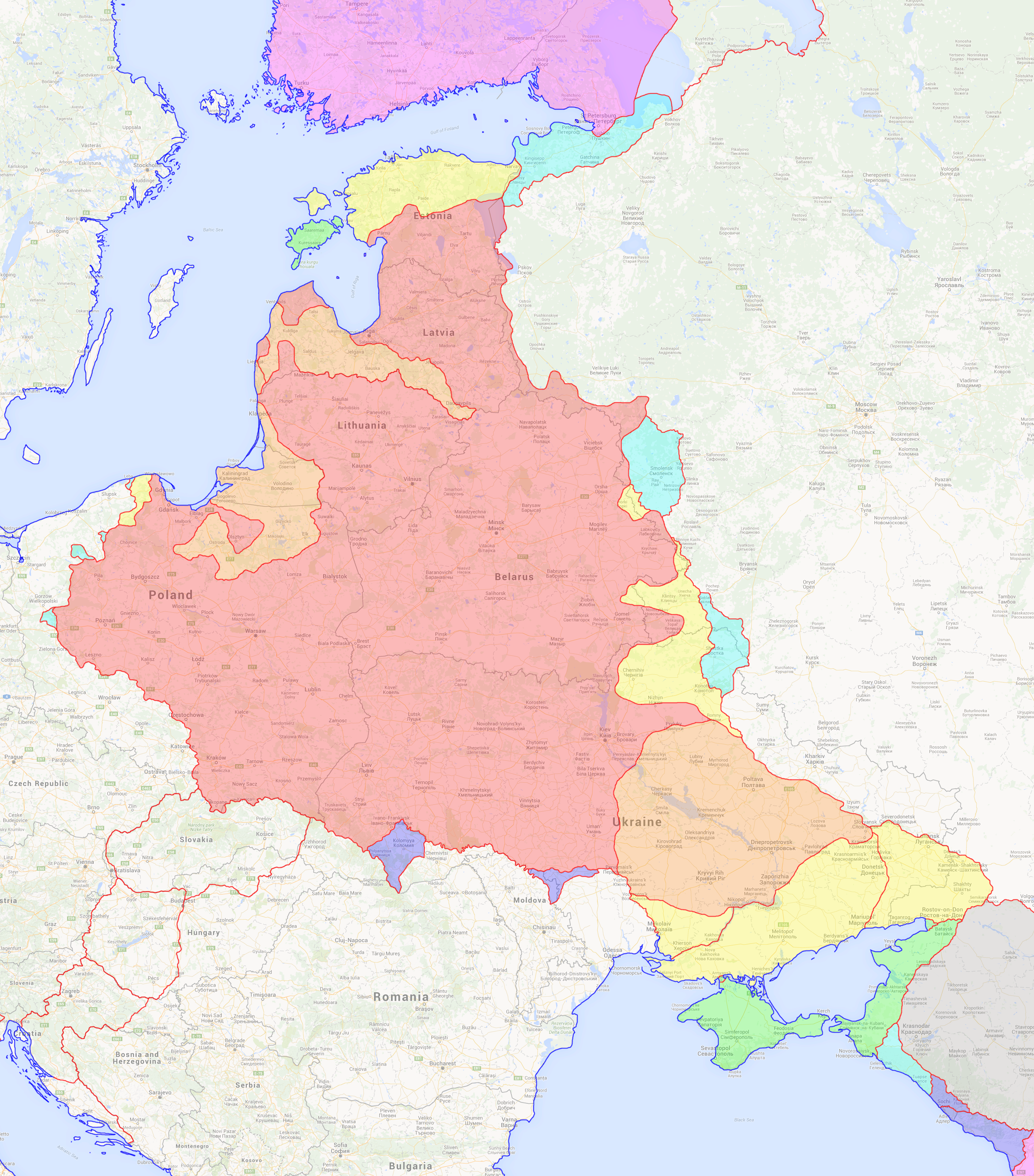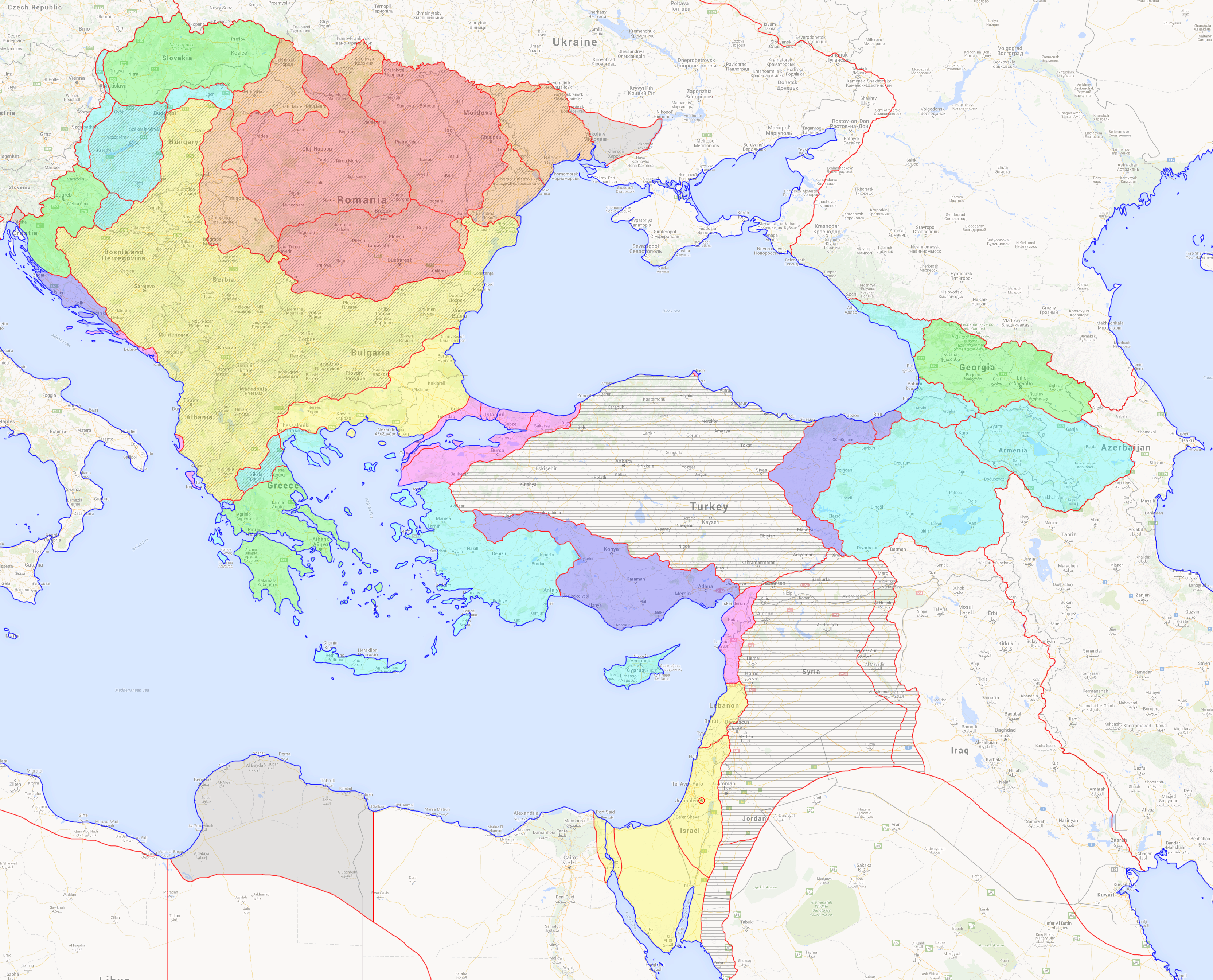I've just read your excellent timeline! I have a couple of questions, if that's okay. Feel free to answer or not answer them as you desire; I won't be offended if you don't want to answer them all. I expect answers to some questions would require spoilers.
1) The recent map showing the demarcation of the Franco-German border shows Dunkirk and its environs remaining part of France, despite being predominantly Flemish-speaking. Why is this?
2) I think you mentioned that Michaelia Iulia remains the Romanian capital city until the present day. Given that the annexation of Constantinople seems very likely at this point, and Constantinople is obviously a very important city even considering its recent destruction, why isn't the Romanian capital ever moved there?
3) Why is Anatolia administered as a colony, while the European territories are directly administered as a part of Romania? There isn't a huge difference between Anatolia and Thrace.
4) What is the current distribution of the constructed Sarmatian Language? Spoken by nobles mostly? Is it mutually intelligible with Polish, Lithuanian, and Ruthenian?
5) Alghero is currently Catalan-speaking. Will it be transferred to Spain, or will its residents be assimilated or expelled?
6) Nationalism is clearly just a means to an ends for the elites to control the masses. Would it be the case that each great power would like to encourage nationalist movements in other great powers that they don't like? Example: Britannia funding Breton nationalists in France.
7) Aren't the Romani (Gypsy) people a fairly significant minority in Romania? I don't see them in the demographics tables.
8) The Dalmatian language, spoken in Ragusa, was traditionally considered a "bridge" between Romanian and Italian. It is now considered to be closer to Italian. Upon the Romanian annexation of Dalmatia, was there an effort to label Dalmatian as a dialect of Romanian?
9) Are the Aromanians under pressure to learn the standard Romanian language and drop their local dialects, or are dialects of Romanian acceptable/encouraged?
10) Does Aromanian nationalism, and unwillingness to assimilate into the larger Romanian nation, exist?
11) In Romanian nationalist thought, would one normally say that the Romanians are *descended from* the Romans, or that they *are* the Romans?
12) Do any hyper-patriotic Romanians want to annex Italy and Rome?
13) There was a mass-migration of veteran peasants and their families from Wallachia, Moldavia, and Transnistria to the rest of Romania in the 1620s. What did the existing residents (Serbs, etc...) think of this? Any protests?
14) Most Orthodox people in the new Romanian territories are assimilating. Are there any that aren't and that are vigorously objecting?
15) In the new Romanian territories like Thrace, there are three categories of people who consider themself Romanian. Firstly the Aromanians who have lived there for a long time, secondly the Romanian veterans who recently immigrated there, and thirdly the Bulgarians etc who have assimilated. Are there many cultural differences between the three groups or are they much the same?
16) Romania has already shown its willingness to use ethnic cleansing (first on the Jews and later on the Hungarians). Upon the conquest of Anatolia, would it be correct to assume that all Turks will be expelled and the newly-emptied lands of Anatolia settled with Romanian veterans?
17) If a native African or Asian state converts to Christianity, would this stop the European Great Powers from attempting colonization there?
18) Contact with Ethiopia. Will it happen soon? Will the European nations treat Ethiopians as being more "civilized" due to their religion?
19) Romania, along with all of the Great Powers, has explicitly defined Islam as a great threat that must be vanquished. How do they reconcile this with being friendly with the Muslim state of Egypt?
20) Is there a chance of Romania completely demolishing Mecca and just leaving some empty sand where the city once stood? As a gesture to show their dominance over Islam.
21) Are the ideals of nationalism considered to only apply to Europe, or are they applicable all over the world? For example, would a Dutch person in British America (the former New Netherlands) be under pressure to learn English?
22) Is Russia expanding eastwards at the same rate that it did in OTL?
23) Assuming the answer to the last question is "yes", then it would appear that the Pacific settlement of Ohkotsk has now been founded. Russia has access to the sea! - only problem is that they want access to the Baltic, Black, or White seas, not some far-off place. However, a port's a port. Will Okhotsk expand faster than in OTL if Russia has no other port?
24) Why did Empress Cristina's guards allow Iulia into the room in the middle of the night? Surely they would have known that Cristina would automatically assume that someone pouncing on her is an assassin?
25) Which/how many languages can Cristina, Iulia, Maria, and Flora speak?
26) Is the seat of the Greek Orthodox patriarchy still located in Constantinople, or has it been relocated somewhere more sensible?
27) I see that a thorough Greco-Turkish population exchange happened. So the Pontic Greeks no longer exist, while Mikrasia now has no Turks and is thoroughly Greek?
28) What's the most populous and/or economically prosperous part of Greece? The European mainland, the islands, or the Asian mainland?
29) Will Romania or Sarmatia attempt to create an Assyrian state out of formerly-Muslim land? Or is Assyria located within the borders of what is now Persia?
30) Has the Armenian population of Cilicia been deported to the new nation-state of Armenia in the population exchanges?
31) Are the Druze seen as acceptable residents in the Romanian Orient, or are they lumped in as "undesirable populations" with other Muslims?
32) We've seen plenty of ethnic cleansing (forced deportations), but no genocide (intentional killing of all members of an ethnic group) yet! I guess the Church would heavily object if someone attempted such a thing?
33) How have Edisan and the new Sarmatian territories been faring in the decades since the Tatars' defeat?
34) On that topic, what actually happened to the Tatars following Sarmatia's occupation of Crimea? Deportation to the Ottoman Empire, or were they allowed to stay?
35) Is there still a Slovakian minority in Perekop?
36) The Romanian Orthodox Church declared Mihai a saint; did any other churches recognize this?
37) Does Slovakia have more Magyars or Slovaks? Judging by the borders, both ethnic groups should be quite numerous.
38) There's a Hanseatic German diaspora in the Romanian ports. Following the formation of the German nation-state, is this population more patriotic towards Romania or towards Germany? In the event of Romania and Germany falling out, would they be a fifth column?
39) How much of Spanish North Africa has been Christianized by now?
40) Spain has attempted to generate a cohesive national identity, but it has three main languages. Aragonese, Castilian, and Portuguese. Which of these is most used? If Castilian, doesn't this upset the Portuguese people?
41) Do the Lipka Tatars in Sarmatia still maintain their Muslim religion, or have most of them converted to Catholicism?
42) With Catholicism being the state religion of Sarmatia, would it be correct to assume that the Orthodox Ruthenians do not tend to be patriotic citizens?
43) Do the Szekelers usually consider themselves Hungarian? Do they consider themself Romanian?
44) Has there been any serious effort to reunite the Catholic and Orthodox churches?
45) Does Kalmykia follow Buddhism still, and if so does the religious difference hinder nationalism in the Russian state? I assume that the predominant religion of Russia is orthodoxy.
46) Why has France made no effort to incite French nationalism?
47) Is Occitan nationalism a realistic prospect at some point in the future due to the lack of French nationalism?
48) Have Romanian families begun to adopt surnames by now?
49) What is the level of literacy amongst younger Romanians, who grew up with the new education system?
50) Is Latin still the standard language of international diplomacy?
1) The recent map showing the demarcation of the Franco-German border shows Dunkirk and its environs remaining part of France, despite being predominantly Flemish-speaking. Why is this?
2) I think you mentioned that Michaelia Iulia remains the Romanian capital city until the present day. Given that the annexation of Constantinople seems very likely at this point, and Constantinople is obviously a very important city even considering its recent destruction, why isn't the Romanian capital ever moved there?
3) Why is Anatolia administered as a colony, while the European territories are directly administered as a part of Romania? There isn't a huge difference between Anatolia and Thrace.
4) What is the current distribution of the constructed Sarmatian Language? Spoken by nobles mostly? Is it mutually intelligible with Polish, Lithuanian, and Ruthenian?
5) Alghero is currently Catalan-speaking. Will it be transferred to Spain, or will its residents be assimilated or expelled?
6) Nationalism is clearly just a means to an ends for the elites to control the masses. Would it be the case that each great power would like to encourage nationalist movements in other great powers that they don't like? Example: Britannia funding Breton nationalists in France.
7) Aren't the Romani (Gypsy) people a fairly significant minority in Romania? I don't see them in the demographics tables.
8) The Dalmatian language, spoken in Ragusa, was traditionally considered a "bridge" between Romanian and Italian. It is now considered to be closer to Italian. Upon the Romanian annexation of Dalmatia, was there an effort to label Dalmatian as a dialect of Romanian?
9) Are the Aromanians under pressure to learn the standard Romanian language and drop their local dialects, or are dialects of Romanian acceptable/encouraged?
10) Does Aromanian nationalism, and unwillingness to assimilate into the larger Romanian nation, exist?
11) In Romanian nationalist thought, would one normally say that the Romanians are *descended from* the Romans, or that they *are* the Romans?
12) Do any hyper-patriotic Romanians want to annex Italy and Rome?
13) There was a mass-migration of veteran peasants and their families from Wallachia, Moldavia, and Transnistria to the rest of Romania in the 1620s. What did the existing residents (Serbs, etc...) think of this? Any protests?
14) Most Orthodox people in the new Romanian territories are assimilating. Are there any that aren't and that are vigorously objecting?
15) In the new Romanian territories like Thrace, there are three categories of people who consider themself Romanian. Firstly the Aromanians who have lived there for a long time, secondly the Romanian veterans who recently immigrated there, and thirdly the Bulgarians etc who have assimilated. Are there many cultural differences between the three groups or are they much the same?
16) Romania has already shown its willingness to use ethnic cleansing (first on the Jews and later on the Hungarians). Upon the conquest of Anatolia, would it be correct to assume that all Turks will be expelled and the newly-emptied lands of Anatolia settled with Romanian veterans?
17) If a native African or Asian state converts to Christianity, would this stop the European Great Powers from attempting colonization there?
18) Contact with Ethiopia. Will it happen soon? Will the European nations treat Ethiopians as being more "civilized" due to their religion?
19) Romania, along with all of the Great Powers, has explicitly defined Islam as a great threat that must be vanquished. How do they reconcile this with being friendly with the Muslim state of Egypt?
20) Is there a chance of Romania completely demolishing Mecca and just leaving some empty sand where the city once stood? As a gesture to show their dominance over Islam.
21) Are the ideals of nationalism considered to only apply to Europe, or are they applicable all over the world? For example, would a Dutch person in British America (the former New Netherlands) be under pressure to learn English?
22) Is Russia expanding eastwards at the same rate that it did in OTL?
23) Assuming the answer to the last question is "yes", then it would appear that the Pacific settlement of Ohkotsk has now been founded. Russia has access to the sea! - only problem is that they want access to the Baltic, Black, or White seas, not some far-off place. However, a port's a port. Will Okhotsk expand faster than in OTL if Russia has no other port?
24) Why did Empress Cristina's guards allow Iulia into the room in the middle of the night? Surely they would have known that Cristina would automatically assume that someone pouncing on her is an assassin?
25) Which/how many languages can Cristina, Iulia, Maria, and Flora speak?
26) Is the seat of the Greek Orthodox patriarchy still located in Constantinople, or has it been relocated somewhere more sensible?
27) I see that a thorough Greco-Turkish population exchange happened. So the Pontic Greeks no longer exist, while Mikrasia now has no Turks and is thoroughly Greek?
28) What's the most populous and/or economically prosperous part of Greece? The European mainland, the islands, or the Asian mainland?
29) Will Romania or Sarmatia attempt to create an Assyrian state out of formerly-Muslim land? Or is Assyria located within the borders of what is now Persia?
30) Has the Armenian population of Cilicia been deported to the new nation-state of Armenia in the population exchanges?
31) Are the Druze seen as acceptable residents in the Romanian Orient, or are they lumped in as "undesirable populations" with other Muslims?
32) We've seen plenty of ethnic cleansing (forced deportations), but no genocide (intentional killing of all members of an ethnic group) yet! I guess the Church would heavily object if someone attempted such a thing?
33) How have Edisan and the new Sarmatian territories been faring in the decades since the Tatars' defeat?
34) On that topic, what actually happened to the Tatars following Sarmatia's occupation of Crimea? Deportation to the Ottoman Empire, or were they allowed to stay?
35) Is there still a Slovakian minority in Perekop?
36) The Romanian Orthodox Church declared Mihai a saint; did any other churches recognize this?
37) Does Slovakia have more Magyars or Slovaks? Judging by the borders, both ethnic groups should be quite numerous.
38) There's a Hanseatic German diaspora in the Romanian ports. Following the formation of the German nation-state, is this population more patriotic towards Romania or towards Germany? In the event of Romania and Germany falling out, would they be a fifth column?
39) How much of Spanish North Africa has been Christianized by now?
40) Spain has attempted to generate a cohesive national identity, but it has three main languages. Aragonese, Castilian, and Portuguese. Which of these is most used? If Castilian, doesn't this upset the Portuguese people?
41) Do the Lipka Tatars in Sarmatia still maintain their Muslim religion, or have most of them converted to Catholicism?
42) With Catholicism being the state religion of Sarmatia, would it be correct to assume that the Orthodox Ruthenians do not tend to be patriotic citizens?
43) Do the Szekelers usually consider themselves Hungarian? Do they consider themself Romanian?
44) Has there been any serious effort to reunite the Catholic and Orthodox churches?
45) Does Kalmykia follow Buddhism still, and if so does the religious difference hinder nationalism in the Russian state? I assume that the predominant religion of Russia is orthodoxy.
46) Why has France made no effort to incite French nationalism?
47) Is Occitan nationalism a realistic prospect at some point in the future due to the lack of French nationalism?
48) Have Romanian families begun to adopt surnames by now?
49) What is the level of literacy amongst younger Romanians, who grew up with the new education system?
50) Is Latin still the standard language of international diplomacy?



